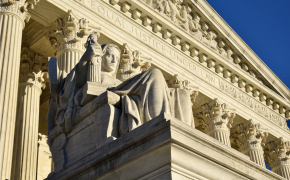2024 Litigation Look Ahead Series: In Property Takings Cases, Court Must Strike Careful Balancing Act Between Regulating Land Use, Protecting Property Rights
B&D is pleased to present the next installment of our 2024 Litigation Look Ahead series. (Read part three covering administrative enforcement issues here.) In this edition, our litigation team examines two Fifth Amendment takings cases currently before the U.S. Supreme Court that could affect the government’s ability to regulate land use legislatively as well as property owners’ right to bring takings claims against states.
Refresher - What is the Constitution’s Takings Clause?
The Fifth Amendment of the U.S. Constitution, applicable to the states through the Fourteenth Amendment, prohibits the government’s taking of private property without payment of just compensation. The courts have established a body of law to determine what government actions affecting the use of private property constitute a “taking” requiring just compensation. These actions include not only the physical seizure of private property but also, in limited circumstances, government regulation of private property that is so restrictive that it amounts to a taking. This is often seen when the government imposes land use regulations. “Regulatory” takings jurisprudence involves the court's balancing of government actions and their effects on the property’s economic value or the extent to which the act interferes with the reasonable expectations of the property owner.
The Fifth Amendment’s Takings Clause is vital to protecting private property rights from excessive government regulation or other conduct that significantly burdens private property. The cases below demonstrate how private property owners and state and local governments are continually testing its boundaries, asserting substantive and procedural arguments which provide the U.S. Supreme Court the opportunity to strengthen or erode its protections.
Sheetz v. County of El Dorado, California, No. 22-1074
Case Summary
In 2016, George Sheetz applied for a permit to build a manufactured home on his property in El Dorado County, California. In response, El Dorado County officials informed Mr. Sheetz they would grant him a permit if he paid a traffic impact fee of more than $23,000, citing its Traffic Impact Mitigation fee program as the basis for the fee. The program, established to finance the construction and widening of roads, authorizes the County to impose fees on builders of new developments. Mr. Sheetz paid the fee under protest and then sued the County, alleging the fee violated the Takings Clause of the Fifth Amendment. Specifically, Mr. Sheetz argued that U.S. Supreme Court precedent requires that if a government compels someone to give up property in exchange for a land use permit, it must show that such a condition is closely related and roughly proportional to the effects of the proposed use. In an unpublished decision, the California trial court rejected Mr. Sheetz’s arguments and upheld the fee, holding that because the statute authorized the fee, it was immune from Nollan and Dolan review (explained below). The California Court of Appeal affirmed, and the California Supreme Court denied review.
The U.S. Supreme Court granted cert on September 29, 2023, and heard oral arguments on January 9, 2024. The Court appeared split during the arguments, with some Justices seeming to agree that conditions imposed on the exercise of property rights are subject to heightened scrutiny, while other Justices questioned how such scrutiny would even be applied.
Implications
Ultimately, this case turns on a dispute over the reach of prior Supreme Court precedent from the cases Nollan v. California Coastal Commission, 483 U.S. 825 (1987) and Dolan v. City of Tigard, 512 U.S. 374 (1994), landmark decisions addressing the contours of government authority to regulate land use. The Nollan Court held that all permit conditions imposed on land development must relate to the actual harm caused by the development. The Dolan Court expanded the scope of Nollan, holding that such government demands must be sufficiently proportional to the actual impacts of the proposed use.
The County argues that the nexus and proportionality test established by Nollan and Dolan is limited to conditions imposed administratively and does not apply to conditions imposed legislatively. Specifically, the County argues that legislation that creates a fee schedule or formula that applies equally to categories of similar properties without seeking any dedicatory interest in land is exempt from such analysis.
Should Mr. Sheetz prevail, the Supreme Court would effectively close what some developers see as a loophole to current precedent. The Supreme Court has the opportunity to expand the Nollan and Dolan precedents to include exactions created by statute. While some may see this as strengthening property rights, local and state governments are concerned that such an expansion would limit, or in some cases eliminate, their authority to enact programmatic land use regulations and charge fees to groups of similarly situated property owners. If the Court expands Nollan/Dolan review to include legislatively imposed development fees, it would impose a significant administrative burden on state and local governments by requiring case-by-case scrutiny.
Devillier v. Texas, No. 22-913
Case Summary
Several property owners in Texas filed separate inverse-condemnation suits against the state under the Fifth Amendment’s Takings Clause and its Texas Constitution counterpart after a state highway project caused widespread flooding on their properties. The Texas Department of Transportation raised the highway’s elevation, added additional lanes, and installed a three-foot traffic barrier on the highway’s centerline to ensure the south side of the highway would remain dry in wet weather and could be available as an evacuation route in the event of a flood. The property owners allege that water that would have otherwise flowed south into the Gulf of Mexico was stopped by the traffic barrier, causing their land – located on the north side of the highway - to flood during heavy rainfall.
The State of Texas removed the cases to the U.S. District Court for the Southern District of Texas and had them consolidated into a single action. The state then moved for judgment on the pleadings, arguing that the property owners could not bring their inverse condemnation claims in federal court directly under the Fifth Amendment without a statutory basis, such as 28 U.S.C. § 1983. (As the property owners pointed out in the petition for writ of certiorari, Texas state courts recognize a takings claim under the U.S. Constitution without requiring a statutory basis. It is only because the State of Texas removed the case to federal court – which changed the substantive law governing the case – that the argument that a statutory basis for the claim became relevant.) The District Court denied the motion but allowed for an interlocutory appeal. The U.S. Court of Appeals for the Fifth Circuit reversed, holding that “the Fifth Amendment Takings Clause as applied to the states through the Fourteenth Amendment does not provide a right of action for takings claims against a state.” The property owners appealed to the U.S. Supreme Court.
The Supreme Court granted cert on September 29, 2023, and heard oral arguments on January 16, 2024. Justices from both ends of the political spectrum recognized that the State of Texas’s position and its “procedural maneuvering” would effectively extinguish the right of private property owners to "just compensation” when the government takes their property for public use. Several justices also recognized that the state’s position appeared to conflict with First English Evangelical Church v. County of Los Angeles, 482 US. 304 (1987). The core holding in First English, that the Fifth Amendment’s Takings Clause is “self-executing”, such that inverse condemnation claims seeking just compensation for a government “taking” do not require a separate statutory basis, was affirmed in Knick v. Township of Scott, Pennsylvania, 139 S. Ct. 2162 (2019). Chief Justice Roberts, who authored the opinion in Knick and more recent takings case, Cedar Point Nursery v. Hassid, 594 U.S. 139 (2021), noted that the state’s position creates "a Catch-22… you say they have to proceed in—in state court. They can't proceed in federal court. And as soon as they do, you remove it to federal court…where you say they can't proceed?" Justice Roberts added that this sort of reasoning was "rejected in Knick." The questions and comments of the various justices at oral argument suggest that the Supreme Court is disinclined to reach a result that would allow states to avoid takings liability by utilizing the procedural tactics deployed by the State of Texas, or which would require overruling Knick.
Implications
If Texas prevails, the decision will reverse decades of constitutional precedent that allows property owners to seek just compensation from the government under the Fifth Amendment’s Takings Clause. Instead, property owners would be barred from bringing a takings claim under the Fifth Amendment against any state until Congress passes a statute that declares states are subject to the Fifth Amendment. Luckily for property owners, the Justices indicated during oral argument that they disagreed with the approach suggested by Texas. Reversing the Fifth Circuit will strengthen the rights of property owners and send a clear message to states looking to avoid takings liability.
In Conclusion
In these regulatory takings cases, the U.S. Supreme Court has the opportunity to protect the government’s ability to enact programmatic land use regulations and strengthen the rights of property owners looking to bring takings claims against states. These cases reflect the Court’s careful balancing between the government’s need to regulate property development and the reasonable expectations of the property owner.
Coming Soon in our Litigation Look Ahead Series…
In our 2024 Litigation Look Ahead series, we highlight cases – environmental and otherwise – that could have notable impacts on the regulated community or lead to changed regulatory approaches. The final installments of the series will examine the Comprehensive Environmental Response, Compensation, and Liability Act (CERCLA) and natural resource law. In case you missed it, read part three of the series covering administrative enforcement issues.
B&D’s litigators are actively involved in and monitor cases in courts nationwide. With decades of experience in toxic torts, class actions, Superfund and site remediation, enforcement defense, regulatory challenges, and business and contract disputes, our litigation team is well-equipped to handle diverse legal matters.











